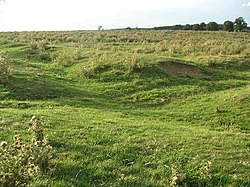Snelshall Priory
| Snelshall Priory | |
|
Buckinghamshire | |
|---|---|
 Site of Snelshall Priory. | |
| Location | |
| Location: | 52°0’7"N, 0°48’47"W |
| Order: | Benedictine |
| History | |
| Disestablished: | 1535 |
| Information | |
| Condition: | Demolished |
Snelshall Priory was a Benedictine priory in Buckinghamshire, and later a country mansion. Both the priory and the house have since been demolished. The site today is within the new town area of Milton Keynes.
The priory was founded around 1200 after Sybil d'Aungerville granted land at Tattenhoe to Lavendon Abbey, who most likely started a cell at Snelshall.[1] Snelshall Priory paid 1 mark a year to Lavendon until 1232, at which point the Bishop of Lincoln decided that Snelshall owned its own lands and chapel. The priory accumulated various land through gifts, but even with all these grants, in 1321 when Henry Burghersh visited, it was so poor that "the monks scarcely had the necessities of life and had to beg even for these".
Yet the priory remained until the mid-sixteenth century. In 1529, Bishop Longford found "irregularities"[1] among the two or three monks that remained, and as a result all women, married and unmarried, were barred from priory. Only two women, both over 48 years old and of "unexceptional character", were retained as servants. In 1535, there remained three monks, two priests (of which one was a novice), the prior's parents with "all their goods" and eight servants. The house was in ruin, and later that year the priory dissolved and house turned over to The Crown.
The house was possibly rebuilt around 1540, possibly by Sir John Fortescue. Much of the priory's land went to the Longueville family.[2]
It is not known when the house was demolished.
The stones were recycled to build the nearby St Giles' Church, Tattenhoe.
Outside links
- Houses of Benedictine monks: The priory of Snelshall' – A History of the County of Buckingham - Volume pp 352-353: {{{2}}} (Victoria County History)
References
- ↑ 1.0 1.1 Markham, Sir Frank (1986) [1973]. History of Milton Keynes and District (Volume 1). White Crescent Press. pp. pp. 104–105. ISBN 0-900804-29-7.
- ↑ Markham, Sir Frank (1986) [1973]. History of Milton Keynes and District (Volume 1). White Crescent Press. pp. p. 146. ISBN 0-900804-29-7.